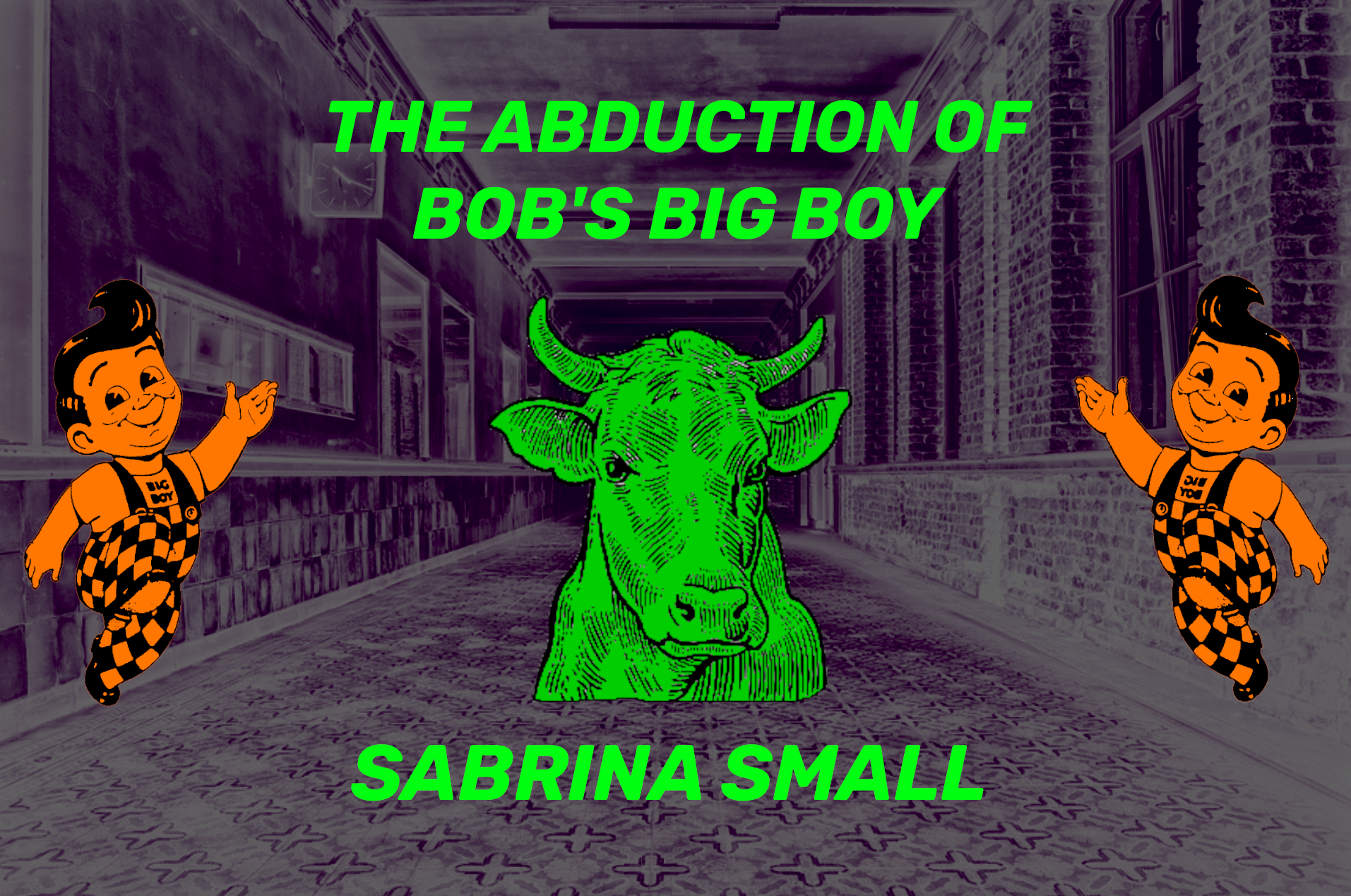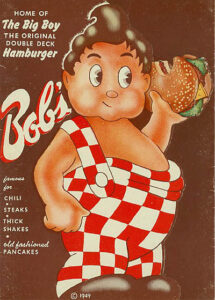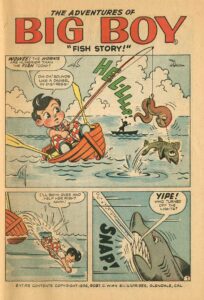The Abduction of Bob’s Big Boy
People are constantly trying to abduct Bob’s Big Boy. The news is littered with these stories.
Do you know Bob’s Big Boy? It’s a chain of burger restaurants that started in LA. The Big Boy’s most notable form is as a fiberglass statue, a tangible mascot placed in front of each restaurant. A statue big enough to lure people from their cars into those Naugahyde tuck-and-roll booths.
Bob is a portly fellow, as the name implies. In one hand, he holds a cheeseburger, big as a plate. His face is really something. Milky white skin, blue eyes cast to the side, cartoonish for mischievous. He’s got a brown cowlick. Cowlick, think about that literally for a second. It’s half Elvis, half Dennis the Menace. He’s got a cherry red smirk, a little more than a Mona Lisa smile. It’s definitely turned up, but there’s something he’s not telling you. He’s got on these loose red checkered overalls. They’re not tight. That’s important. You could definitely get a hand down there, easy. Two simple snaps if you want to take it all the way down. He’s got on a t-shirt that says BIG BOY and big blue clown shoes that match his eyes. I’m not doing it justice. Just go look. Please, it will make the rest of this way easier.1
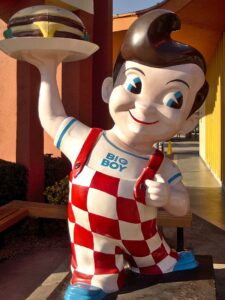 This kid is not from my time. I was born and raised in the 80s, the era of made for tv movies. The era of stranger danger. The era of DARE.2 Bob’s Big Boy is the 50s made fast food iconography. He is Bob Wills singing Roly Poly…Daddy’s Little Fatty. He’s very goyish. His chubby cheeks need squeezing. He’s Bob’s Big BOY. You’re a good boy. You’re a good boy. Yes you are. He’s nameless because he belongs to BOB. But I kept searching and I found him. I found out his real identity.
This kid is not from my time. I was born and raised in the 80s, the era of made for tv movies. The era of stranger danger. The era of DARE.2 Bob’s Big Boy is the 50s made fast food iconography. He is Bob Wills singing Roly Poly…Daddy’s Little Fatty. He’s very goyish. His chubby cheeks need squeezing. He’s Bob’s Big BOY. You’re a good boy. You’re a good boy. Yes you are. He’s nameless because he belongs to BOB. But I kept searching and I found him. I found out his real identity.
I know his first name is Richard.
We ate there when I was a kid. I mean, we were Jews, so we didn’t eat there a lot. But me and my sisters gravitated to anything with a cartoon mascot. We were curious. Now it feels sinister, like those Jeffrey Epstein teens that lured in other teens to work as massage therapists. The BIG BOY is a pied piper of sorts for his masters.
They had pudding pies and milkshakes. They had the expected burgers and fries but also breaded shrimp and a soup of the day. Bob’s had a full breakfast menu, a lunch-buffet with jello. But this was much later. Initially it was a burger stand near Warner Bros. studios, run on a shoestring budget by a man named Bob Wian.
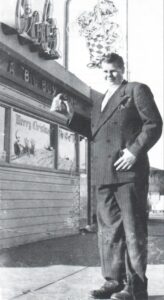
Photo from bobs.net
The origin story of the Big Boy is actually quite pervy. It’s based on a real kid, six year old Richard Woodruff, described as “a ruddy young boy who helped around the stand in exchange for burgers.” This was 1936 or 37, a time that seems unknowable to me, a decade that fell through the cracks. When I recount what I know, it’s bleak: The Depression, Dust Bowl, Grapes of Wrath, birth of the talkies. It was also the dawn of Disney and animated entertainment.
There was a Warner Brothers cartoonist, Ben Washam, who frequented what was then known only as Bob’s Pantry on his lunch break. He was so taken with little Dickey Woodruff that he drew a caricature of him, a chubby boy (despite The Great Depression) in loose red checkered overalls munching on a burger. His mouth is mid bite. He has no shirt beneath his overalls, which appear to be falling down, one snap undone due to his weight or boyish carelessness.
This quick drawing3 sparked a frenzy. The image adorned napkins, menus, and condiment bottles. It was drafted into a comic of its own, written by the legendary Stan Lee. The comic, which was handed out as promotional material, stretched all the way into the 70s.
So there you have it. The Big Boy is Richard Woodruff. Rich, Richie, Dickey, Dick. The kid that was always around after school, just helping out. Wiping down tables in the hopes of being rewarded with a juicy burger, a Double Decker.4
Bob’s Big Boy Comics
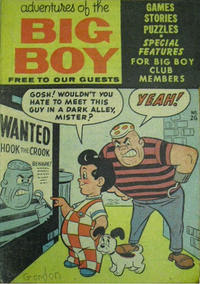 The comics are rare as fuck and hard to track down. They’ve never been reproduced so they’re hoarded by Marvel-heads, Americana-heads, comic nerds. The bit of them I’ve seen, though, is thematically rich. The conceit is that Big Boy is so trusting, so good natured and willing to see the good nature in others, that he doesn’t know when evil is upon him. In one, Big Boy is standing in front of a wanted poster with the criminal behind him. He doesn’t recognize that they are one and the same, and remarks to his burly companion, “Gosh! Wouldn’t you hate to meet this guy in a dark alley, Mister?” The criminal replies “YEAH!” through snarled teeth, his left hand replaced by a sharp metal hook.
The comics are rare as fuck and hard to track down. They’ve never been reproduced so they’re hoarded by Marvel-heads, Americana-heads, comic nerds. The bit of them I’ve seen, though, is thematically rich. The conceit is that Big Boy is so trusting, so good natured and willing to see the good nature in others, that he doesn’t know when evil is upon him. In one, Big Boy is standing in front of a wanted poster with the criminal behind him. He doesn’t recognize that they are one and the same, and remarks to his burly companion, “Gosh! Wouldn’t you hate to meet this guy in a dark alley, Mister?” The criminal replies “YEAH!” through snarled teeth, his left hand replaced by a sharp metal hook.
In another comic5 Big Boy dives into the mouth of a shark trying to save a damsel in distress.
I became obsessed with tracking these comics down. I wanted to see if all of them were a variation on the boy in danger plot. From what I was able to find, this theory holds up. I read through two full issues from the 50s and in one, the plot was especially juicy. A sailing trip gone awry lands Big Boy and his sidekick (girlfriend?) Dolly on a strange island inhabited by headhunters. They drag Big Boy back to their lair where, low and behold, the hunted heads are revealed to be sculptures and the hunters are revealed to be artists working a scam where they charge mainlanders for their “savage” heads.
Stranger Danger
Los Angeles in the 1980s is a hazy splatter-paint collage for me. A mix of memories of the most primal order: the stewed-beef smell of my great grandmother’s apartment, family photo shoots at Sears, roller-skating on Venice Beach. It’s only when we hit the 90s that I can be counted on for anything remotely like accuracy. But I do remember milk carton kids. I remember them because they’re how I learned to read. M-I-S-S-I-N-G, MISSING. I sounded that word out and my parents went…ooh!6
In a town a stone’s throw from Yosemite National Park, seven year old Steven Stayner was approached by a man looking for church donations. He asked Steven if he thought his mother would be willing to donate for a good cause. Steven said yes. The man, Kenneth Parnell, asked Steven if he wanted a ride to his house. Steven said yes. The man rode to a cabin nearby and held Steven as a child sex slave until 1980. He changed his name to Dennis Parnell and they lived under the guise of father and son, across many of California’s forgotten towns. Steven eventually escaped at 14, with his intended replacement, a 5 year-old boy named Timmy White, abducted a few weeks earlier in Ukiah.
When Steven was reunited with his family, there was a media frenzy,7 culminating in the made for TV mini series, I Know My First Name is Steven, which detailed the horror of years living under an assumed identity and the fretful reunion of Steven and his family. The mini series left out the sex abuse,8 but that part became public during the televised trial.
1980, the year Steven escaped, is the year I was born. It’s also the year Bob’s Big Boy ran tv commercials with the slogan “Bob loves kids and kids love Bob”
In LA children are exploited.
There’s a lauded industry built on this principle and it fucks kids up. I dabbled in these dark arts as a child. I came very close to being on Kids Incorporated (the irony of this name is NOT lost on me, don’t worry). I was slated to get this role on the premier kid’s variety hour of the 1980s. Kids Incorporated was canned and insincere with a loose plot, covers of pop songs, and rigidly choreographed dance numbers. It was the dance numbers that did me in. I was 11 but didn’t know my right from left. I just could not get the hang of it. It required so much fucking spatial awareness. I am like the arrow on google maps, quivering and spinning in a panicked way as you search for your destination. So when they asked me to dance, I refused.
My mom was somehow familiar with one of the casting agents. Maybe they went to UCLA together? Anyway, he told her that I had it. It was in the bag and all I had to do was show a willingness to dance, show that I might be teachable. I refused right to her pleading eyes as she explained this all to me. I have no idea if this was:
- Self sabotage
- Divine intervention from a spirit beyond our world, Shirley Temple, perhaps
- A real phobia in the face of choreography9
- A real phobia in the face of being taught anything
Anyway, Jennifer Love Hewitt got the role instead. Back then she went by the first name LOVE, which seemed sick to me. Fuckin groovy.10
The Kid’s Incorporated, that is Hollywood, was a well greased machine by the time I stepped onto it. They held casting calls at my elementary school in Sherman Oaks, a stone’s throw from the porn studios. I remember my sister and I both auditioned and followed the Ellis Island entry line of hundreds of kids, where we were separated into two slightly smaller camps: Models and Actresses. My sister got model and I got actress. I watched her move on with the other lithe, doe-eyed girls and walked on with my sisters. We of the ethnic nose; we of the ratty teeth; we of the portly proportions.
Even though I went on to touch the embers of near fame a few times and my sister never once appeared on a runway, I felt she was the chosen one. Pretty beats everything else, always has.
If your sense of being pretty is connected to your sense of being sexy, it can go one of two ways, but it usually goes both: What is sexy if it’s received positively? How much of that vibe is self possession and how much of it is the transactional nature of sexiness, the fact that sexy usually implies an audience, an arbiter, a judge. When I say I find myself sexy, I mean I feel empowered, confident, alluring, in possession of some essence that has sexual value. Beyond that, sexy becomes a less self-possessed concept, which might also be a positive experience. If it’s about achieving power (and sexy is a currency you control) that experience can be positive. I don’t think seeking validation always equates with low self worth. I think it can play out like a Wall Street bro with his money. There must be Wall Street bros that are fairly well rounded people. Is Warren Buffet in a very public S&M relationship with the stock market? I think so. Is he a psychopath because of it? Maybe not. Just because you need to be reminded that you picked well, that you made it rain, doesn’t mean you’re not happy.
This version of sexiness, one that feeds off of validation, undermines a lot of women. A sexy actress is not just an actress. A sexy model is not just a model. Is a model ever allowed to be just a model? Do we even value this as a career choice, something that requires talent? Or is it always assumed that a model is cashing in? A sexy scientist, a sexy librarian. Sexy changes everything here. A woman scientist… very different woman comes to mind for me….Someone who wears fleece. Sexy is a negative judgment most of the time. Think sugar babies, cam girls, real housewives, gold diggers, strippers, porn stars. Now go darker. Go to the number one assumption behind every sexy stripper or porn star:
Child sex abuse.
Anyone who uses sexuality for money is accused of being a victim of child sex abuse, if they get famous enough. What do we do with the fact that it’s often true?
Sexy is a loaded compliment. It’s uncomfortable to use the word sexy to describe a child. There are many people, though, who find children sexy. Tracy Lorde’s step dad found her sexy enough, at 12, to molest her. She made pornography as a minor.11 Her step dad got her into the business. He took her down to Van Nuys in 1984, just blocks away from my home, and introduced her to the kindly cowboy that ran the show, Jim South, the only man that refused to sleep with Tracy. She was so popular. She blew up the industry. Her sex scenes were ferocious.
The stories of child stars in the throws of the worst human suffering are boundless. Addiction, sexual abuse, accidental overdose, purposeful suicide, psychosis in later life, PTSD, domestic abuse, spousal abuse. I could go on but I don’t have to because this isn’t news. It’s the price of admission.
Van Nuys
Shortly before puberty, I find myself in a situation I’ve been unconsciously training for my entire life. I live in Van Nuys, the seedier suburb next to Sherman Oaks. Sherman Oaks has the Galleria (where Fast Times was filmed). It has the good fro-yo, and charming cottages. Van Nuys has motels, where bottom of the barrel prostitutes work and bottom of the barrel hotels, where low-end escorts work. It has the rubber-burned smell of being so close to the freeway.
We live off of Burbank Blvd, where the 101 meets the 405. We live on Noble Ave. My porn name is Deanne Noble, which is less porny than my actual name.
Van Nuys is the birthplace of industrial pornography. In the shadows left by the Hollywood hills, Porn Valley came to prominence. It was the era of Deep Throat, when the audience for porn expanded beyond greasy men with skinny mustaches. My parents saw Behind the Green Door, on one of their early dates. Porn was for the general god-fearing public and lots of films needed to get made quick. The smell of money to be made was everywhere. For so many–actors, producers, and cameramen–filming porn was akin to driving an Uber in your off hours. Quick and dirty. Fast money.
In the 80s and 90s, Van Nuys set up porn production studios. I ride my bike to the end of the block and see a woman with a headband and lace panties running after a fluffy white dog. Bright sunlight. Her hands and bare feet are tan. Nails, neon pink. She grabs the dog and stuffing him under her nose, walks slowly back inside, whispering and rubbing her face against him as they both disappear into warehouse darkness.
My parents are often approached by film crews asking to “use our house for a movie.” They never do it. When I start watching the Playboy channel, I recognize a backyard, a mantle piece and flood with the secret information that I am watching someone get fucked at Jamie Baron’s house.
Two blocks from my home there are seedy motels where prostitutes can be spotted outside. They scare me. They look like sad people, not like barbies. Across the street from the motel there is a strip mall trying to bring Van Nuys some god damned respectability. It has a Kinkos, a Pier One, and Party World, which is where I am headed most of the time. Party World has everything you need for your upcoming event–over the hill birthday, baptism, Quinceniara, or rinky dink wedding. There are many pinatas to choose from and because it is a one-stop shop, there is also candy to fill the pinatas with. This candy lines the wall in lucite bins. They charge by the piece or bulk. I can usually scrounge up a buck’s worth of change and get a sampling of Laffy Taffy, Mike & Ike’s, and individually wrapped Jaw Breakers.
The walk from my house to Party World is 10 minutes. On the way, I notice the scuffed red car following me because it was so obviously following me. I try not to look at the driver. I walk purposefully without running. Running in this situation seems dangerous, like running when you see a bear. Before you run, there’s a chance you can convince the bear you’re an adversary but once you bolt, he knows he’s got you. You be prey.
I look over enough to see that the guy looks kind of like my Uncle Allan. No–don’t worry. It isn’t my actual uncle. Can you imagine? Fuck! It’s just a small white guy with aviators, a pastier version of Mathew Mconaughy in Dazed and Confused. The car is a piece of shit. When I look at him, he looks back at me unabashedly. He is hungry and he isn’t trying to hide it.
I make it to the strip mall and run into Kinkos. Inside copy machines buzzing, the chemical warmth and scent of hot paper, the uniformed employees in khaki pants and cornflower blue polo shirts; worlds away from what is outside. And he is still outside. He is parked right in front. I find a spot in Kinkos where I can see him but he can’t see me. Eventually he leaves.
Then I did what? I don’t remember. Did I walk home alone? Did I call my parents from the Kinko’s and have them pick me up? It’s wild that I can’t remember anything past his car leaving and my heart slowing down.
In 1939 Nathaniel West wrote Day of the Locust and Bob’s Big Boy became a beloved mascot.
I bring this up because it’s easy to mistake the past for something innocent.
Why are you picking on little old Bob’s Big Boy? He’s just a sweet little boy who loves burgers. Why do you have to bring this depraved element into it? Those were different times, traditional times. The dawn of WWII, FOR GOD’S SAKE! You think our fighting heroes would do something so vile…with a child?
But then there’s West and he gives it to you so dirty it’ll still make your head spin. Altruism nee humanity is almost non-existent in Day of the Locust. It’s a book that splays the ugly out like a banana peel and lets it rot in the sun. West offers up a disturbing and unflinching portrait of exploitation in many guises. He presents a Hollywood that can only be entertained when someone is getting hurt, where violence is a plot point.
That something so thin could have such a torpid heaviness to it.
David Lynch’s Big Boy period
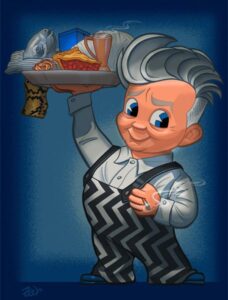 David Lynch was drawn to Bob’s Big Boy. He held a standing daily appointment for 7 years (halfway through Eraser Head up to the end of Dune) at the original Burbank location. During this stretch of the 1980s, Lynch would take meetings, work on ideas and consume an Andy Warhol sort of lunch of coffee and chocolate milkshakes. He claims to have timed his Big Boy visits (2:30 pm exactly) to the consistency of the shakes. If he got there too early, the shakes were soupy. If he came too late, they were basically soft-serve.
David Lynch was drawn to Bob’s Big Boy. He held a standing daily appointment for 7 years (halfway through Eraser Head up to the end of Dune) at the original Burbank location. During this stretch of the 1980s, Lynch would take meetings, work on ideas and consume an Andy Warhol sort of lunch of coffee and chocolate milkshakes. He claims to have timed his Big Boy visits (2:30 pm exactly) to the consistency of the shakes. If he got there too early, the shakes were soupy. If he came too late, they were basically soft-serve.
For seven years his muse was a diner with a creepy child mascot. We know this makes sense for Lynch. His universe is full of looking glass refractions of Americana. Every diner is a universe unto itself and Lynch mined the Burbank Bob’s Big Boy for his art. He got high on sugar and caffeine and jotted down ideas on napkins covered with Bob’s Big Boy chubby face and rictus smirk. He found enough inspiration in these coffee-soaked, sugar-saturated afternoons to dedicate almost a decade of his life there. One day, for example, Lynch “saw a man come in. He came to the counter, and that’s all I remember of this man, but from seeing him came a feeling, and that’s where Frank Booth came from.” Blue Velvet‘s psychotic, gas-huffing, Dennis Hopper-portrayed villain grew out of a moment and a feeling, a disjointed hunch.
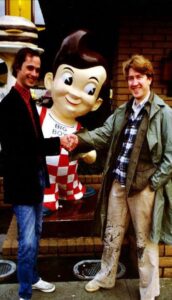 Sugar and coffee are drugs we can imbibe legally all day. But they are drugs and Lynch knew this. He referred to sugar as a great help and a friend. He dubbed it “granulated happiness.” The idea that something as innocent as happiness, can be manufactured by a specific combination of substances and atmosphere is potent. David Lynch is telling us sugar is not innocent. There is no Big Rock Candy Mountain, no Candy Land where children frolic in fields of gum drops. The boy is not real. He is a statue. He is a menu. He is a napkin you can write your ideas on. He will not protest. You can do whatever you want to him. You can make sugar dark. You can make innocence menacing. Bob’s Big Boy is a manufactured child. A child preserved in the amber of 50s Americana; an era that elicited, in Lynch, a perverse delight. His films create a sense of uncanny dread and psychic discomfort in me. Lynch can find evil in a dumpster behind a diner in broad daylight.
Sugar and coffee are drugs we can imbibe legally all day. But they are drugs and Lynch knew this. He referred to sugar as a great help and a friend. He dubbed it “granulated happiness.” The idea that something as innocent as happiness, can be manufactured by a specific combination of substances and atmosphere is potent. David Lynch is telling us sugar is not innocent. There is no Big Rock Candy Mountain, no Candy Land where children frolic in fields of gum drops. The boy is not real. He is a statue. He is a menu. He is a napkin you can write your ideas on. He will not protest. You can do whatever you want to him. You can make sugar dark. You can make innocence menacing. Bob’s Big Boy is a manufactured child. A child preserved in the amber of 50s Americana; an era that elicited, in Lynch, a perverse delight. His films create a sense of uncanny dread and psychic discomfort in me. Lynch can find evil in a dumpster behind a diner in broad daylight.
Baby Fingers
Montclair Preparatory School is on Sepulveda Blvd, deep in the Valley. The school used to be a motel. So did the nicer school I went to after that. Some of our classes were in FEMA-like trailers set up in the parking lot. It cost a lot of money and we wore uniforms. In the courtyard near the cafeteria, they cemented the pool that used to be there and covered it with shitty metal tables and benches. This was our informal lunch area. There were never enough seats, so kids sat against the wall of the motel, finding shade where they could. LA is so hot. Hot all year.
Around lunch time the payphone in the courtyard rang and it was always this pervert who spoke obsessively of baby fingers in mouths. Not to bite them off. It wasn’t violent. It was just a fetish. He could not stop going on about it. The conversation would go like:
“Hi”
“Hi”
“Who is this?”
“Have you ever stuck a baby’s hand in your mouth?”
“Huh?”
“Have you ever stuck those little fingers in your mouth and then the whole hand up to the wrist?”
“No.”
“Can you put someone else on?”
He was looking for someone who got it. I get it. It wasn’t me. I felt the wrongness of his questions and couldn’t find the upper hand the way other kids could. His breathing was so intense, a character separate from his voice. His voice sounded fat and stuffed up, maybe with baby fingers, who knows. I was just trying to eat my chicken fingers and get through the day.
You know there are graveyards where multiple Big Boys are buried?
The statues are damaged, deformed, decapitated. One visitor’s account opens, “To be honest, it was quite obscure. It’s not often you come across a molded fiberglass version of one of your favorite childhood cartoon characters tipped over in the woods — with a big hole in the side of his head. Not to mention there were three Big Boys. It was evident upon arrival that this was indeed a graveyard.”
Graveyards are like icebergs. All we see, as we walk across the manicured lawn, are carved stones with names and dates. What lies beneath our feet is more complicated, more nuanced and unknowable. What does it look like down there? Six feet under? This exercise requires imagination. It relies on your individual experience with death and burial, your knowledge of how materials decompose–wood and hair and clothing fibers.
A graveyard is a place you go to pretend that death has borders and boundaries. We tell ourselves It belongs here, in this palatable setting, with flowers and trees. But this is fiction. Death goes where it wants to and usually leaves no trace. In between the graveyard and the imperceptible place, there are small memorials, fading slowly over time. Once they were heartfelt and clean but over time ribbons tear, teddy bears turn mangy.
A graveyard can be a feeling. A graveyard can be a vibe. People are constantly trying to abduct Bob’s Big Boy. The news is littered with these stories.
Bob’s Big Boy is watching you; always has been. You’ve briefly glimpsed him this once, but he’s been there all along. He was watching you on the day you were born, and he’ll be watching you the day you die. He will always be there. Watching. Judging. Barely containing his rage, and quietly biding his time. He’ll be waiting for you, in the end. God help you when that day finally comes. (Sixteen Severed Hands, Reddit user)
- Bob’s Big Boy Statues.
- Side note: I spent every DARE hour having elaborate fantasies about getting too-high and ending up in the LA basin, drowning as I tried to grip dolphin smooth concrete walls.
- Ben Washam version Bob’s Big Boy (source: animationresources.org)
- The original double-deck hamburger was invented at Bob’s Big Boy. It had a sesame bun that was sliced twice to create a middle piece of bread. If it sounds familiar, it’s because it has had hundreds of restaurant imitators, including the most famous one, the McDonald’s Big Mac.
- All comic images made possible through collector Nick Caputo.
- Ok, that’s fiction. But it’s good, right? It really drew you in. you were like, maybe she’s gonna pull a thematic rabbit out of her hat. This will all make sense in the end.
- For more coverage of this story and the permutations of this story on the Stayner family, I highly recommend Jessica Dimmock’s Captive Audience: A Real American Horror Story.
- The story they told on TV was that Parnell was a strange, lonely man who wanted a son and went so far as to steal one. He was depicted as violent but not sexually abusive. Maybe the public bought this story. Some of us are wired to buy any version that’s not the absolute worst version.
- I LIKE dancing. I dance a lot but it’s not graceful. It’s funny, herky jerky, and I’m ok with that. I have a history of sitting out ballet classes, just opting out mid-lesson and going to the waiting room to sit with my mom and read magazines. She was cool about it, surprisingly. She adopted a hands-off attitude with me very early on.
- Went down a long, stoned Youtube rabbit hole of Kids Incorporated and came away with massive respect for Marta Marrero, better known as Martika.
- While I was working on this, I binged the Lili Anolik podcast, Once Upon A Time In The Valley. The experience of walking around Berlin but being so viscerally linked to the place I grew up in was surreal and unsettling. Lili Anolik has a very seductive and robotic voice, which is also unsettling.
